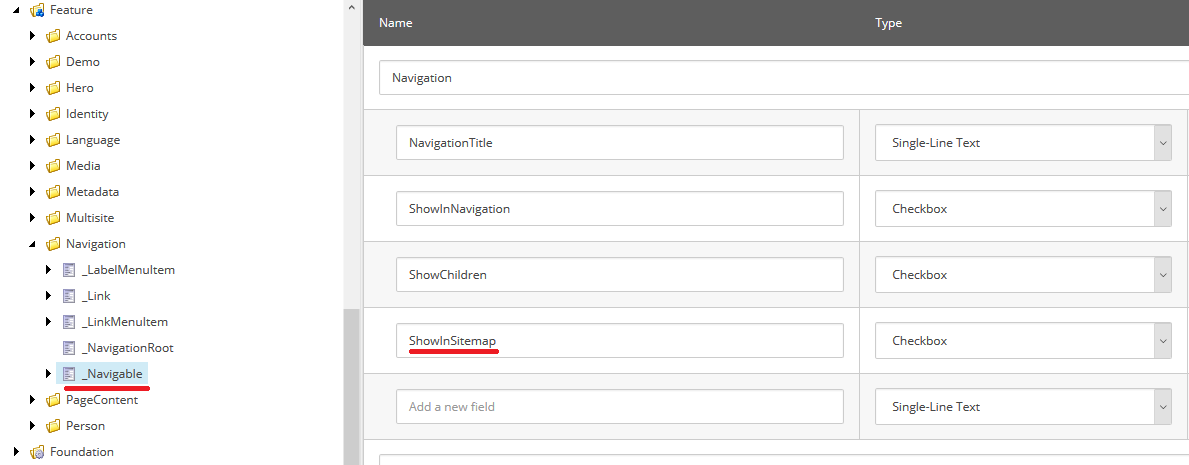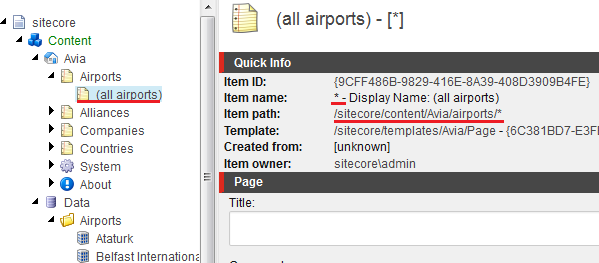I am working on a solution that already has HTML sitemap as a part of Navigation feature. Now I got a request to add also a basic XML sitemap with common set requirements. Habitat ships with an interface template _Navigable, so let's extend this template by adding a checkbox field called
ShowInSitemap, stating whether a particular page will be shown in that sitemap:

In order to start, we need to create a handler. Having handlers in web.config is not the desired way of doing things, it will require also doing configuration transform for the deployments, so let's do things in a Sitecore way (Feature.Navigation.config file):
<configuration xmlns:patch="http://www.sitecore.net/xmlconfig/">
<sitecore>
<pipelines>
<httpRequestBegin>
<processor type="Platform.Feature.Navigation.Pipelines.SitemapHandler, Platform.Feature.Navigation"
patch:before="processor[@type='Sitecore.Pipelines.HttpRequest.CustomHandlers, Sitecore.Kernel']">
</processor>
</httpRequestBegin>
<preprocessRequest>
<processor type="Sitecore.Pipelines.PreprocessRequest.FilterUrlExtensions, Sitecore.Kernel">
<param desc="Allowed extensions">aspx, ashx, asmx, xml</param>
</processor>
</preprocessRequest>
</pipelines>
</sitecore>
</configuration>
We rely on httpRequestBegin pipeline and incline our new SitemapHandler from Navigation feature right before CustomHandlers processor.
SitemapHandler is an ordinary pipeline processor for httpRequestBegin pipeline, so is inherited from HttpRequestProcessor:
public class SitemapHandler : HttpRequestProcessor
{
const string sitemapHandler = "sitemap.xml";
private readonly INavigationRepository _navigationRepository;
public SitemapHandler()
{
_navigationRepository = new NavigationRepository(RootItem);
}
public override void Process(HttpRequestArgs args)
{
if (Context.Site == null
|| args == null
|| string.IsNullOrEmpty(Context.Site.RootPath.Trim())
|| Context.Page.FilePath.Length > 0
|| !args.Url.FilePath.Contains(sitemapHandler))
{
return;
}
Response.ClearHeaders();
Response.ClearContent();
Response.ContentType = "text/xml";
try
{
var navigationItems = _navigationRepository.GetSitemapItems(RootItem);
string xml = new XmlSitemapService().BuildSitemapXML(flatItems);
Response.Write(xml);
}
finally
{
Response.Flush();
Response.End();
}
}
private Item RootItem => Context.Site.GetRootItem();
private HttpResponse Response => HttpContext.Current.Response;
}
And XmlSitemapService code below:
public class XmlSitemapService
{
public string CreateSitemapXml(IEnumerable<NavigationItem> items)
{
var doc = new XmlDocument();
var declarationNode = doc.CreateXmlDeclaration("1.0", "UTF-8", null);
doc.AppendChild(declarationNode);
var urlsetNode = doc.CreateElement("urlset");
var xmlnsAttr = doc.CreateAttribute("xmlns");
xmlnsAttr.Value = "http://www.sitemaps.org/schemas/sitemap/0.9";
urlsetNode.Attributes.Append(xmlnsAttr);
doc.AppendChild(urlsetNode);
foreach (NavigationItem itm in items)
{
doc = CreateSitemapRecord(doc, itm);
}
return doc.OuterXml;
}
private XmlDocument CreateSitemapRecord(XmlDocument doc, NavigationItem item)
{
string link = item.Url;
string lastModified = HttpUtility
.HtmlEncode(item.Item.Statistics.Updated.ToString("yyyy-MM-ddTHH:mm:sszzz"));
XmlNode urlsetNode = doc.LastChild;
XmlNode url = doc.CreateElement("url");
urlsetNode.AppendChild(url);
XmlNode loc = doc.CreateElement("loc");
url.AppendChild(loc);
loc.AppendChild(doc.CreateTextNode(link));
XmlNode lastmod = doc.CreateElement("lastmod");
url.AppendChild(lastmod);
lastmod.AppendChild(doc.CreateTextNode(lastModified));
return doc;
}
}
Also, NavigationItem is a custom POCO:
public class NavigationItem
{
public Item Item { get; set; }
public string Title { get; set; }
public string Url { get; set; }
public bool IsActive { get; set; }
public int Level { get; set; }
public NavigationItems Children { get; set; }
public string Target { get; set; }
public bool ShowChildren { get; set; }
}
Few things to mention.
1. Since you are using LinkManager in order to generate the links, you need to make sure you have full URL path as required by protocol, not the site-root-relative path. So you'll need to pass custom options in that case:
2. Once deployed to production, you may face an unpleasant behavior of HTTPS links generated along with 443 port number (such as . That is thanks to LinkManager not being wise enough to predict such a case. However there is a setting that make LinkManager works as expected. Not obvious
var options = LinkManager.GetDefaultUrlOptions();
options.AlwaysIncludeServerUrl = true;
options.SiteResolving = true;
LinkManager.GetItemUrl(item, options);
or better option in Heliix to rely on Sitecore.Foundation.SitecoreExtensions:
item.Url(options) from
//TODO: Update the code with the recent
That's it!
As you probably know, there is a feature in Sitecore, called "wildcard items". Let's say you have a folder where multiple subitems suppose to be and should be presented by similar pages. Sitecore allows you create a wildcard item named "*" (asterisk) so that it will serve any request to this folder. Let's take a look on example below:

Here we see clear separation of pages and data. Airports page has the only child - wildcard page item that is highlighted (and you see its details). Below, in /Data folder, there is a corresponding data sources for each of the airport.
In usual scenario, there should be a page item created for each of airports from /data folder, and page's presentation details screen should have that data items set as the datasource for corresponding rendering (yes, we are on MVC here). But how to have this working, if we have only one universal page item? We have a rendering called Airport to display airport info, but how should we specify the datasource to it?

The rendering relies on RenderingContext.Current.Rendering.DataSource as usual. And instead of datasource of specific airport, we get "*" item as the datasource in all cases, regardless of what airport's page we're loading.
I wanted to leave page's datasource and rendering untouched, as normal implementation. Instead, I decided to incline into mvc.getRenderer pipeline and resolve datasources for "*"-wildcard-items dynamically, based on the URL requested, so that rendering get corresponding data item from RenderingContext.Current.Rendering.DataSource. And of course, as "*"-items serves all possible requests to its folder, I must provide datasources only for matching data items, redirecting all the rest to 404 error page (since there's no data for the page - there's no sense in such a page).
So here's my implementation of wildcard datasource resolver:
Airport
Code referenced from configuration patch file:
public class WildcardDatasource : GetRendererProcessor
{
public string RenderingName { get; set; }
public override void Process(GetRendererArgs args)
{
if (args.PageContext.Item.Name == "*" && args.Rendering.RenderingItem.Name.IsSameAs(RenderingName))
{
string datasourceFolder = args.Rendering.DataSource.IsOK()
? args.Rendering.DataSource
: string.Format("{0}/{1}", Paths.DataFolder.TrimEnd('/'), args.PageContext.Item.Parent.Name);
string dataSourcePath = string.Format("{0}/{1}", datasourceFolder,
args.PageContext.RequestContext.HttpContext.Request.Url.Segments.Last());
var dataSourceItem = Sitecore.Context.Database.GetItem(dataSourcePath);
if (dataSourceItem != null)
{
args.Rendering.DataSource = dataSourcePath;
}
else
{
// process 404 page not found
}
}
}
}
Things to improve in future:
- Add support for nested wildcards
- Find the way wildcard items work with Page Editor